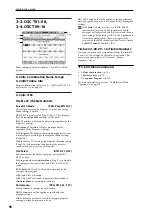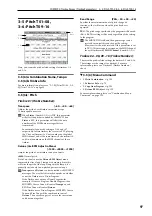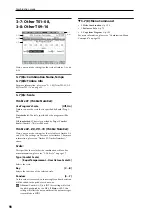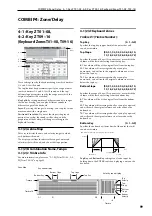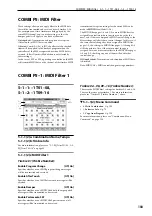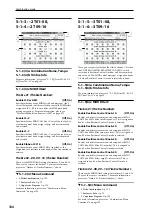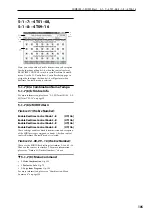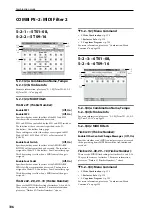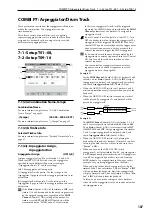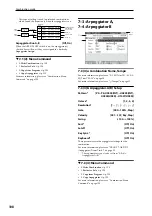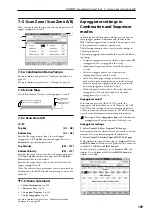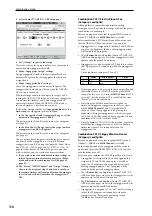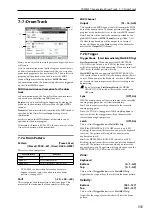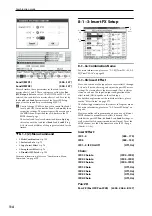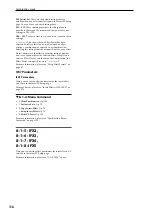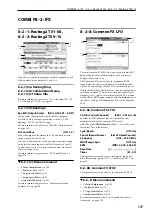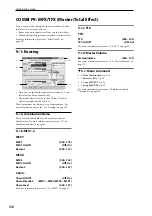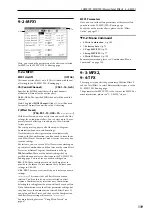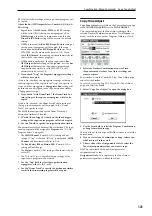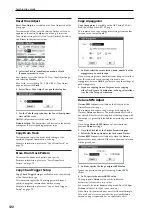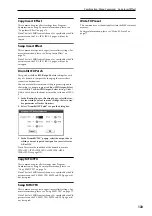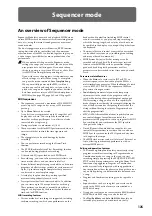
Combination mode
110
3. Select Combi P7: ARP/DT– ARP Setup page.
4. Set “
(Temp)” to specify the tempo.
This is the same as for a program. However, the tempo is
shared by both arpeggiators
A
and
B
.
5. Make “Arpeggiator Assign” settings.
Assign arpeggiator A or B to the desired timbres. Each
timbre will be played by the arpeggiator that has been
assigned to it.
6. Make “Arpeggiator Run” settings.
Check the arpeggiator(s) that you want to operate. The
arpeggiator(s) checked here will run when the ARP ON/
OFF switch is turned on.
With the settings shown in the display for steps 2 and 3,
turning the ARP ON/OFF switch on will cause arpeggiator
A to operate for timbres 1 and 2, and arpeggiator B to
operate for timbre 3. When the ARP ON/OFF switch is
turned off, timbres 1–4 will sound as a layer.
If all timbres
Assign
are
Off
, or if
Arpeggiator Run
A
or
B
is
unchecked
, the arpeggiator will not function.
7. In the Arpeggiator A and Arpeggiator B pages, set the
parameters for arpeggiators A and B.
The parameters for A and B are the same as for a program
(see page 59).
8. In the Scan Zone A/B page, specify the range in which
arpeggiators A and B will operate.
The parameters for A and B are the same as for a program
(see page 61).
You can use keyboard ranges or velocity ranges to operate
one or both of the arpeggiators, or to switch between
arpeggiators A and B. By using the Combi P4: Zone/Delay,
Key Z T01–08 – T09–16 page, and Vel Z T01–08 – T09–16
page to set keyboard and velocity ranges in conjunction
with each other, you can create even more variations.
9. If you wish to save the edited combination settings in
internal memory, turn off memory protect in Global
mode, and write the combination (see OM page 89,
page 91).
10. The “Status,” “MIDI Channel” and “Assign” settings
shown in the display of steps 2 and 3 can be made so
that certain timbres will sound only when the arpeggia-
tor is On, and will be silent when the arpeggiator is
Off.
Combination C027: Electric Piano & Sax
(Category: LeadSplits)
Although this is a somewhat sophisticated editing
technique, we will describe the settings of one of the preset
combinations as an example.
Before you play, make sure that the global MIDI channel
(Global P1: MIDI Basic
MIDI Channel
) is set to
01
.
Select combination C027: Electric Piano & Sax, make sure
that the ARP ON/OFF switch to turn it on, and play.
• Arpeggiator A is assigned to T (timbre) 3 and 5. When
you play the keyboard, the bass riff arpeggio pattern
will sound the T3 program.
• The A
Bottom Key
and
Top Key
(Combi P7: ARP/DT–
ARP Scan Zone page) are set so that arpeggiator A will
operate only for notes B3 and lower.
• Arpeggiator A is also assigned to T5, but this is so that
the T3 program will sound only when the arpeggiator
is on.
Notice the timbre settings for T3 and T5
• If the arpeggiator is off, playing the keyboard will sound
the timbre(s) that are set to Gch or to the global MIDI
channel (in this case, 01). Since the
MIDI Channel
of T3
is set to 02, it will not sound. T5 is set to Gch, but since
“Status” is Off it will not sound.
• Notes from any MIDI channel that is assigned to a
timbre will trigger the arpeggiator. In this case, these
will be
MIDI Channel
02 and Gch (global MIDI
channel). When the arpeggiator is on, playing the
keyboard will trigger arpeggiator A, which is assigned
to T5 (Gch). T3 will be sounded by arpeggiator A. Since
the
Status
of T5 is Off, it will not sound.
• Since the
Status
of T5 is Off, it will not sound, regardless
of whether the arpeggiator is on or off. It is a dummy
timbre that causes T3 to sound only when the
arpeggiator is on.
Combination C015: Skippy Wants to Dance!
(Category: LeadSplits)
Before you play, make sure that the global MIDI channel
(Global P1: MIDI Basic
MIDI Channel
) is set to
01
.
So that the operation of the arpeggiator will be easier to
understand, press the DRUM TRACK ON/OFF switch to
turn the drum track off.
Select and play combination C015: Skippy Wants to Dance!.
• Arpeggiator A is assigned to T3, and arpeggiator B is
assigned to T5 and T8. When you play a note B3 or
lower, the T3 program will be sounded by the synth
backing arpeggio pattern. The T5 program will be
sounded by the bass riff arpeggio pattern.
• The A
Bottom Key
and
Top Key
(Combi P7: ARP/DT–
ARP Scan Zone page) are set so that arpeggiators A will
operate only for the note C4 and above.
• The B
Bottom Key
and
Top Key
(Combi P7: ARP/DT–
ARP Scan Zone page) are set so that arpeggiators B will
operate only for the note B3 and below.
• Arpeggiator B is assigned to T8 as well, but this setting is
so that the T5 program will sound only when the
arpeggiator is on. Refer to the preceding section
“Combination Electric Piano & Sax.”
Status
MIDI Channel
Assign
T3
INT
02
A
T5
Off
Gch
A
Содержание M50-73
Страница 1: ...2 E Parameter Guide ...
Страница 86: ...Program mode 78 ...
Страница 132: ...Combination mode 124 ...
Страница 222: ...Sequencer mode 214 ...
Страница 297: ...Effect Mixer Block Diagrams Main Outputs 289 ...
Страница 418: ...Appendices 410 ...

